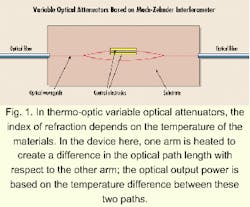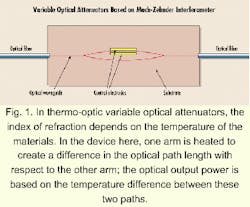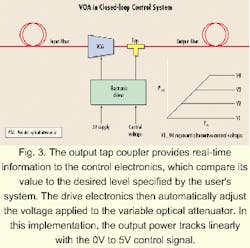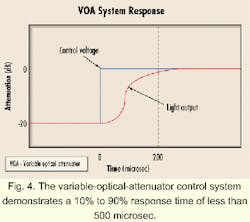New breakthrough design for VOAs based on electro-optic materials
This solid-state technology can quickly attenuate signals in optical networks and holds promise for other active components.
Demand for active photonic components that allow carriers to fully control the network in the optical domain is escalating as dense wavelength-division multiplexing (DWDM) systems continue to revolutionize the communications industry. Equipment vendors have made substantial investments to develop optical switches, tunable optical filters, and optical add/drop multiplexers-active devices that can dramatically improve network speed, capacity, and reliability.
Advances in the area of variable optical attenuators (VOAs), which play a crucial role in controlling optical signal levels throughout the network, exemplify this trend. One such development is the introduction of VOAs that control the level of attenuation by changing the index of refraction in an electro-optic (EO) material through application of an electric field. These devices offer excellent optical specifications and high-speed operation. Moreover, the EO materials technology behind this VOA approach is applicable to other active components such as optical switches and optical filters.
In the last several years, designers have begun to use VOAs extensively. Two major network applications have surfaced to date--channel equalization and the simultaneous attenuation of multiple wavelengths between stages in an erbium-doped fiber amplifier (EDFA).
In DWDM systems, it is often critical to equalize the optical power in all channels. Direct control of a laser's drive current is not desirable, however, because changes cause an unacceptable wavelength shift. In metropolitan networks today, absolute laser output is buffered, often without the use of an EDFA, to accommodate a wide range of distances between nodes.
The simultaneous attenuation of multiple wavelengths between EDFA stages enables tuning of the amplifier for the specific span length/attenuation that follows. It can also reduce the spectral gain tilt induced in the EDFA by changes in optical power (i.e., the adding or dropping of channels).
In addition to network applications, instrumentation manufacturers are increasingly turning to VOAs to enhance the performance of test equipment. For example, VOAs contribute to tunable-laser-instrumentation performance by enabling a smooth vernier adjustment to laser output power. VOAs can also maintain constant output power during a sweep across a range of wavelengths.
Most VOAs in production today use a mechanical means to effect attenuation. This is accomplished through the separation, or the alignment, of fiber endfaces; fiber microbending; or, most often, by the mechanical interference of the light beam by a stepper motor driven blade or filter. These designs offer good optical performance, but with some tradeoffs. One is slow speed, the typical settling times for a 10-dB shift in attenuation range from 100 to 500 msec. Other tradeoffs include the noise induced by the current surges required to activate the motor drive and the possibility of mechanical malfunction through wear. In an era when the use of electronics is considered an intrusion in the all-optical network, mechanically based devices seem out of place.
To overcome some of these limitations, nonmechanical VOAs now reaching the market use a variety of design concepts. Thermo-optic devices take advantage of the dependence of the index of refraction on material temperature. In Mach-Zehnder interferometric configuration, one arm is heated to create an optical path-length difference with respect to the second arm. Thus, the output optical power depends on temperature difference between these two paths (see Fig. 1). Several companies have produced this type of device with good results, except for high (>=2 dB) insertion loss caused by the fiber/substrate junction.Another thermo-optic approach is the side-polished fiber wherein a polymer in close proximity to the fiber core changes its index with temperature, affecting the amount of light coupled out of the fiber. While the optical characteristics are attractive, the response time is slow and reliability remains unproven.
A third alternative is the magneto-optic approach that operates as a variable isolator. A magnetic garnet plate is placed between two collimators, as in an isolator, and an electric coil is used to adjust the magnetic field. These devices demonstrate high speed (<1 msec response time) with adequate optical performance.
Another technology approach is a lithium niobate (LiNbO3)-based VOA that is integrated with a companion LiNbO3 modulator. This combination takes advantage of the already polarized laser input signal and is useful in single-wavelength control for channel equalization in DWDM networks. Because of its single polarization limitation and high coupling losses, this VOA technology cannot be efficiently used in multiwavelength power control, or when single-wavelength control is not immediately adjacent to both a laser source and a companion LiNbO3 modulator.
Over the past five years, advances in materials technology allowed the development of VOAs that combine desirable optical properties with all solid-state reliability and speed. These devices are built around the use of an EO material as the control mechanism.
The use of EO materials in optical networks is not new. Today, LiNbO3 modulators contribute significantly to optical-network operation. These devices have been widely accepted because they demonstrate high modulation rates and outstanding reliability of less-than-100 failure-in-tests.
VOAs have been manufactured using materials with substantially higher EO coefficients than LiNbO3, which leads to fundamentally important performance differences. LiNbO3 devices are only implemented as planar waveguide Mach-Zehnder interferometers because the low EO coefficient necessitates an interaction length measured in centimeters. This design exhibits relatively high insertion loss (4 to 5 dB) and is suitable only for use with linearly polarized light.In contrast, materials with a high EO coefficient enable the design of devices using a non-guided, free-space configuration. In this case, light travels perpendicular to the EO material's surface, enabling low insertion loss and polarization-insensitive operation. These devices are constructed in a manner similar to that of isolators, a well-understood network component (see Fig. 2). Light is introduced via an input collimator; it passes through an EO element and exits by way of an output collimator. Attenuation control is affected by adjusting the electric field within the EO element--modification of the material's index of refraction changes the level of light output.
The results to date have been significant. VOAs occupying only 260 mm2 (0.4 inch2) offer 25-dB dynamic range. In the future, this small size will enable the integration of several optical functions (VOA arrays, attenuator/filter combination, etc.) in a very compact package. In addition, the optical characteristics are excellent. Typical wavelength-dependent loss and polarization-dependent loss are 0.25 dB at 15-dB attenuation, with insertion loss less than 1 dB. Evolution of this technology will enable even better optical results.Both types of control systems have a 10% to 90% response time of less than 500 microsec (see Fig. 4). Both systems show outstanding repeatability; after 20 million cycles from minimum insertion loss to a 20-dB attenuation, the control voltage versus the attenuation curve remained accurate within 0.01 dB. Temperature stability for the entire system from -5°C to +65°C is <0.3 dB.
In all telecommunications systems, device reliability is paramount. The strong similarity between the construction of VOAs based on EO materials technology and optical isolators provides a proven path to excellent reliability. The VOAs were tested according to Bellcore 1209 and 1221 protocols with excellent results. Units subjected to 85°C and 85% relative humidity have survived more than 1000 hours with <0.15-dB shift in insertion loss. Similarly, minor shifts in insertion loss were measured following 100 cycles of -40°C to +70°C temperature cycling.
This electro-optic based VOA technology is ready for network implementation. In the future, this technology can evolve to include devices with internal optical taps for compact system-level packaging. In addition, VOA arrays covering a group of channels can be implemented in a straightforward fashion.
The basic free-space device topology used in these VOAs can also be applied to other high-functionality network devices. This technology has been used to demonstrate light modulators, tunable filters, and optical switches that are inherently polarization-insensitive. It can be used to produce new multifunctional EO devices for high-speed lightwave systems.
Materials with high EO coefficients now offer a robust technology not only to modulate light signals, but also to attenuate them in a precisely controlled manner. This important new platform technology is now available for controlling and routing of lightwave signals in optical networks.
Stephen Cohen is director of sales and marketing and can be reached at e-mail: [email protected] and Paul Melman is a senior staff scientist at NZ Applied Technologies (Woburn, MA) and can be reached at e-mail: [email protected].
In addition, Peter Norris, the company's chief executive officer, and Dean Tsang, a senior staff scientist, contributed to this article.




